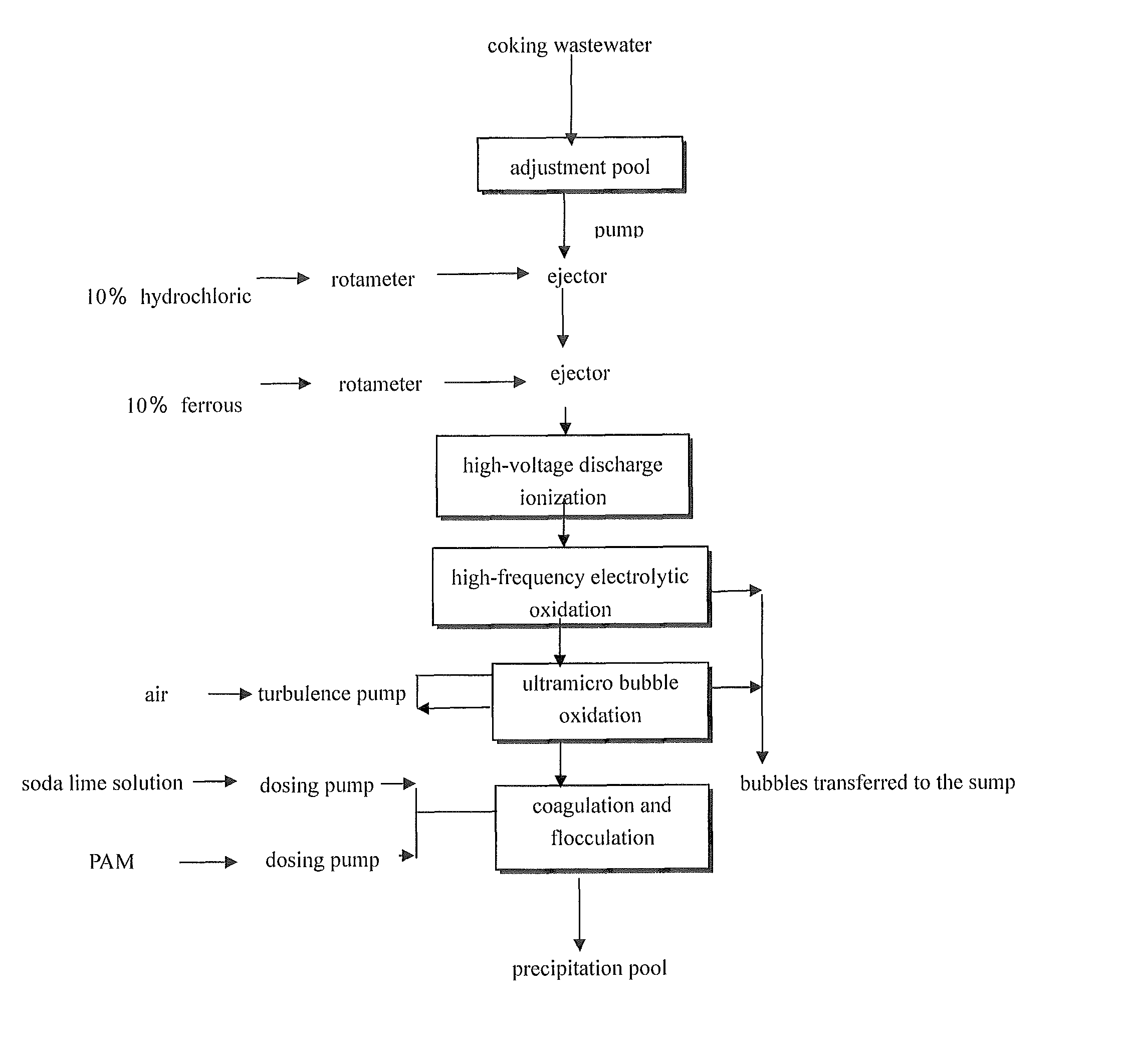Method integrating electrochemical oxidation and flocculation processes for pre-treatment of coking wastewater
a technology of electrochemical oxidation and flocculation, which is applied in the direction of biological water/sewage treatment, water/sewage multi-stage treatment, separation process, etc. it can solve the problems of inability to meet the national legal discharge requirements for coking wastewater purification, inability to meet the national legal discharge requirements, and existing techniques that present undesirable effects in coking wastewater treatment, etc., to achieve high efficiency, high cost, and effective removal of one or two pollution indices
- Summary
- Abstract
- Description
- Claims
- Application Information
AI Technical Summary
Benefits of technology
Problems solved by technology
Method used
Image
Examples
embodiment 1
[0042]The A-O biochemical process was adopted to treat the coking wastewater in one iron and steel plant. The total retention time of this A-O system was 36 hours wherein A (anoxic) stage took 6 while O (oxic) stage 30 hours. The sludge recycle flow was 30% of wastewater inflow while air-water ratio in the aeration area was 30:1. All post-treatment pollution indices failed to satisfy Chinese highest discharge standard (the analysis of raw and treated water is shown in table 1).
[0043]When the electrolytic oxidation and flocculation reactor (treatment capacity: 1 ton / hour) of this invention was applied in combination with a A-O processing equipment (treatment capacity: 1 ton / hour), all post-treatment pollution indices met Chinese highest discharge standard. The specific process flow includes: pumping the wastewater through ejectors into the electrolytic oxidation and flocculation reactor. During pumping, 30% hydrochloric acid was automatically added into the wastewater and its amount ...
embodiment 2
[0045]The A-O biochemical process was adopted to treat the coking wastewater in one iron and steel plant. The total retention time of this A-O system was 36 hours wherein A (anoxic) stage took 6 while O (oxic) stage 30 hours. The sludge recycle flow was 30% of wastewater inflow (volume ratio) while air-water ratio in the aeration area was 30:1 (volume ratio). All post-treatment pollution indices failed to satisfy Chinese highest discharge standard (the analysis of raw and treated water is shown in table 2).
[0046]When the electrolytic oxidation and flocculation reactor (treatment capacity: 1 ton / hour) of this invention was applied in combination with an A-O processing equipment (treatment capacity: 1 ton / hour), all post-treatment pollution indices met Chinese highest discharge standard. The specific process flow includes: pumping the wastewater through ejectors into the electrolytic oxidation and flocculation reactor. During pumping, 30% hydrochloric acid was automatically added into...
embodiment 3
[0048]The A-O biochemical process was adopted to treat the coking wastewater in one iron and steel plant. The total retention time of this A-O system was 36 hours wherein A (anoxic) stage took 6 while O (oxic) stage 30 hours. The sludge recycle flow was 30% of wastewater inflow (volume ratio) while air-water ratio in the aeration area was 30:1 (volume ratio). All post-treatment to pollution indices failed to satisfy Chinese highest discharge standard (the analysis of raw and treated water is shown in table 3).
[0049]When the electrolytic oxidation and flocculation reactor (treatment capacity: 1 ton / hour) of this invention was applied in combination with an A-O processing equipment (treatment capacity: 1 ton / hour), all post-treatment pollution indices met Chinese highest discharge standard. The specific process flow includes: pumping the wastewater through ejectors into the electrolytic oxidation and flocculation reactor. During pumping, 30% hydrochloric acid was automatically added i...
PUM
| Property | Measurement | Unit |
|---|---|---|
| current density | aaaaa | aaaaa |
| diameter | aaaaa | aaaaa |
| retention time | aaaaa | aaaaa |
Abstract
Description
Claims
Application Information
 Login to View More
Login to View More - R&D
- Intellectual Property
- Life Sciences
- Materials
- Tech Scout
- Unparalleled Data Quality
- Higher Quality Content
- 60% Fewer Hallucinations
Browse by: Latest US Patents, China's latest patents, Technical Efficacy Thesaurus, Application Domain, Technology Topic, Popular Technical Reports.
© 2025 PatSnap. All rights reserved.Legal|Privacy policy|Modern Slavery Act Transparency Statement|Sitemap|About US| Contact US: help@patsnap.com


